Why might a lawn mower vibrate badly when it’s in operation? What are the potential causes of excessive vibration, and how can you resolve them?
We’ve discussed everything you should know in this guide.
✅Key Takeaways:
Some vibration is normal when operating a lawn mower because of the combustion process in the engine, the rotation of the cutting blades, and the movement of various components within the mower.
Your lawn mower might vibrate excessively due to an unbalanced blade, a worn or damaged blade, loose components, engine issues, around the crankshaft, and mowing on uneven terrain.
You can fix excess vibration by addressing the cause of the problem, such as straightening a bent blade, using a blade balancer to stop the blade from being heavier on one side, or fixing the crankshaft.
Table of Contents
🤷♂️ Is It Normal For A Lawn Mower To Vibrate?
Yes, it’s normal for a lawn mower to vibrate to a certain degree during operation. These vibrations are caused by several factors, including the vibration of the engine, the rotation of the cutting blades, and the mower’s interaction with the ground.
While these vibrations are usually not severe and are considered part of the normal operation, you’ll still be able to feel them when your hands are on the mower’s handles.
📑 8 Reasons For A Badly Vibrating Lawn Mower
So, why does a walk-behind lawn mower vibrate excessively? If your lawn mower is vibrating more than it usually does, here are the possible causes:
⚖️ Reason #1: Unbalanced Or Loose Blade
An unbalanced blade can cause excessive vibration in a lawn mower due to the uneven weight distribution at either end of the blade. A loose blade may also cause vibration due to it wobbling as it spins.
There are a number of potential causes of unbalanced blades in your mower, including normal wear and tear, damage, or incorrect installation.
When a mower blade is unbalanced, its center of mass shifts away from its axis of rotation. As the unbalanced blade spins, it generates uneven centrifugal forces, causing the mower deck to vibrate.
The severity of the vibrations depends on just how unbalanced the blade is, and the speed at which it rotates.
How To Resolve:
To rectify this issue, inspect your mower blades after the initial assembly and before every use for signs of damage, imbalance, or wear. An unbalanced blade will produce an uneven cut, so also check the quality of your grass after cutting. If some sections are higher than others, the mower blade is likely to blame.
If your blade is imbalanced, try reinstalling it in case it was installed incorrectly. You can also use a mower blade balancer to reduce the vibrations and produce a more even cut.
If the blade is loose, simply tighten it to resolve the issue.
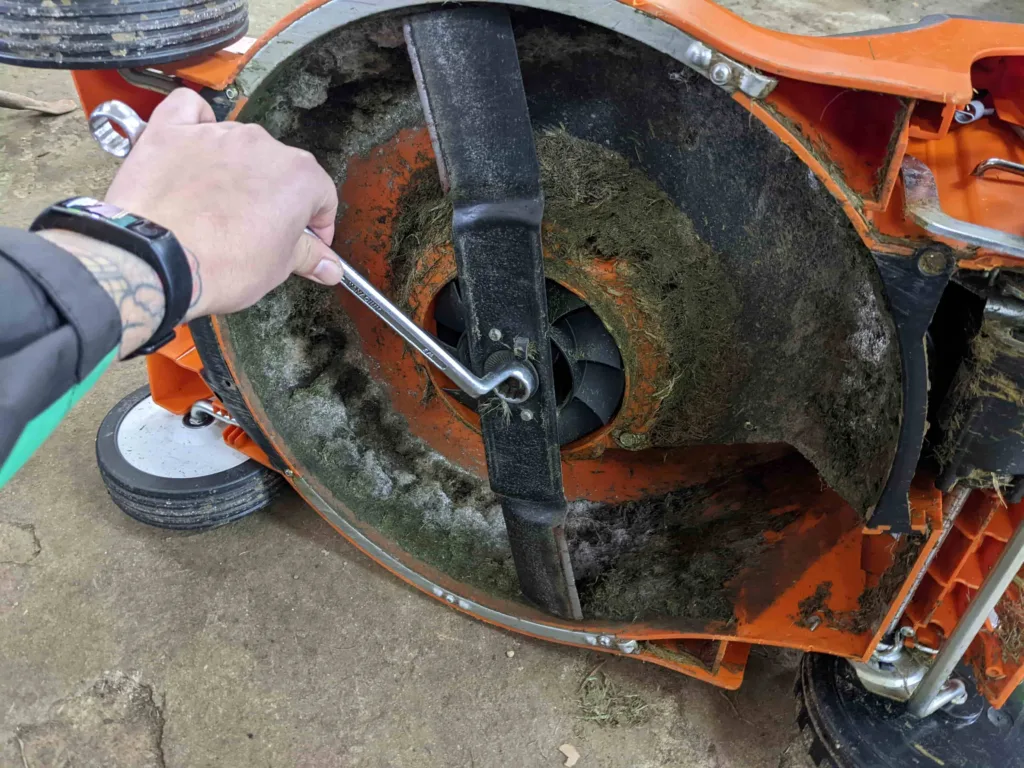
✂️ Reason #2: Worn/Damaged Blades
Worn or damaged blades are another common cause of a lawn mower vibrating. It’s normal for your mower blade to become worn with regular use, and it may become damaged by corrosion from damp conditions, mowing over debris, or impact with hard objects like rocks, tree stumps, or other hidden obstacles in the grass.
Your mower blades may gradually lose their optimal shape and balance, causing them to rotate unevenly and increasing vibration. Even blunt blades may cause your lawn mower to vibrate more than normal.
How To Resolve:
The solution to this issue depends on the cause. Start by examining your mower blade to identify the problem, looking for nicks, dents, wear, and bluntness.
If the cutting blade needs sharpening, that’s the place to start. Most lawn mowers have rotary blades, which need sharpening at least once a year. Check out our guide on how to sharpen a lawn mower blade for the step-by-step process.
You can replace the blade with a new one if you think it’s damaged beyond repair. Replacement mower blades are available in most DIY stores and on Amazon – just make sure to check that the blade is the right size for your mower deck width.
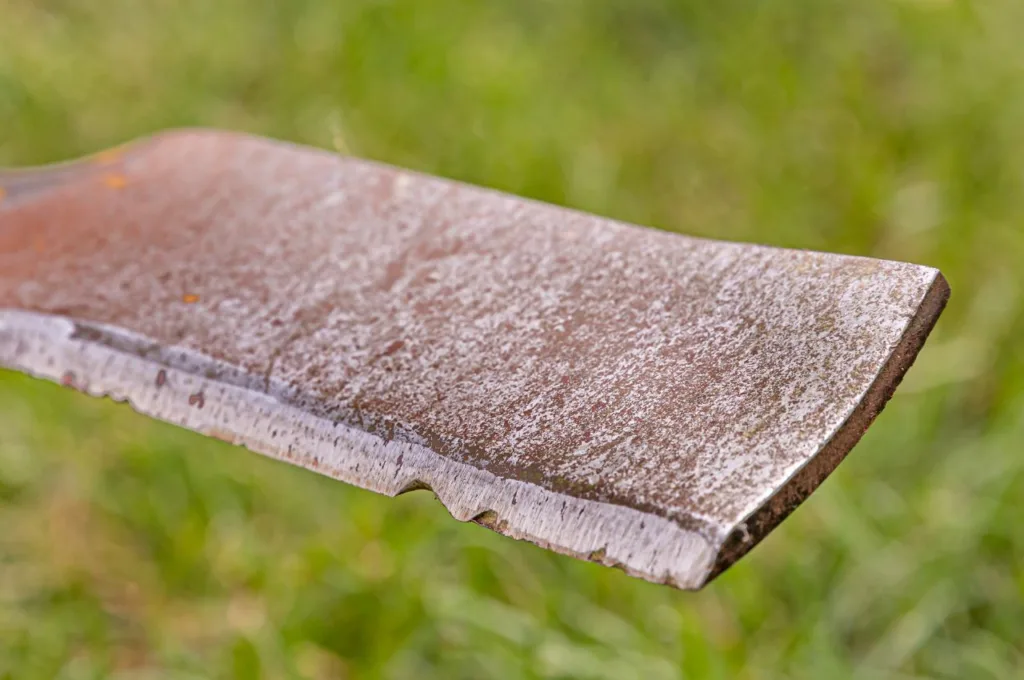
🧰 Reason #3: Clogged Or Damaged Crankshaft
A clogged or damaged crankshaft in your lawn mower could also be the reason why it’s vibrating.
There are a few possible causes of clogging in, or damage to, the crankshaft, including a lack of maintenance, contaminated oil use, excessive dirt and debris buildup due, or a lack of proper lubrication.
When the crankshaft becomes clogged or damaged, it disrupts the smooth rotation of the engine’s internal components, resulting in uneven and jerky movements that cause the mower to vibrate excessively during operation.
Plus, a clogged or damaged crankshaft can also affect the engine’s overall performance, leading to reduced power output and increased vibrations as the engine struggles to operate efficiently.
How To Resolve:
You can resolve the issue of a clogged or damaged crankshaft by conducting a thorough inspection to identify the extent of the damage or blockage, then taking steps to address the issue at hand.
Here are some of the steps you might need to take:
If you notice clogging or debris, clean the area around the crankshaft meticulously to remove any obstructions.
If the issue is related to contaminated oil, drain the old oil and replace it with fresh oil (whatever is recommended by the manufacturer).
If a lack of lubrication is causing or exacerbating certain issues, make sure to properly lubricate the crankshaft and other moving engine components.
If the crankshaft itself is damaged, repairing it may be beyond your DIY abilities. You might need to pay for a professional repair or replacement, which involves disassembling the engine.
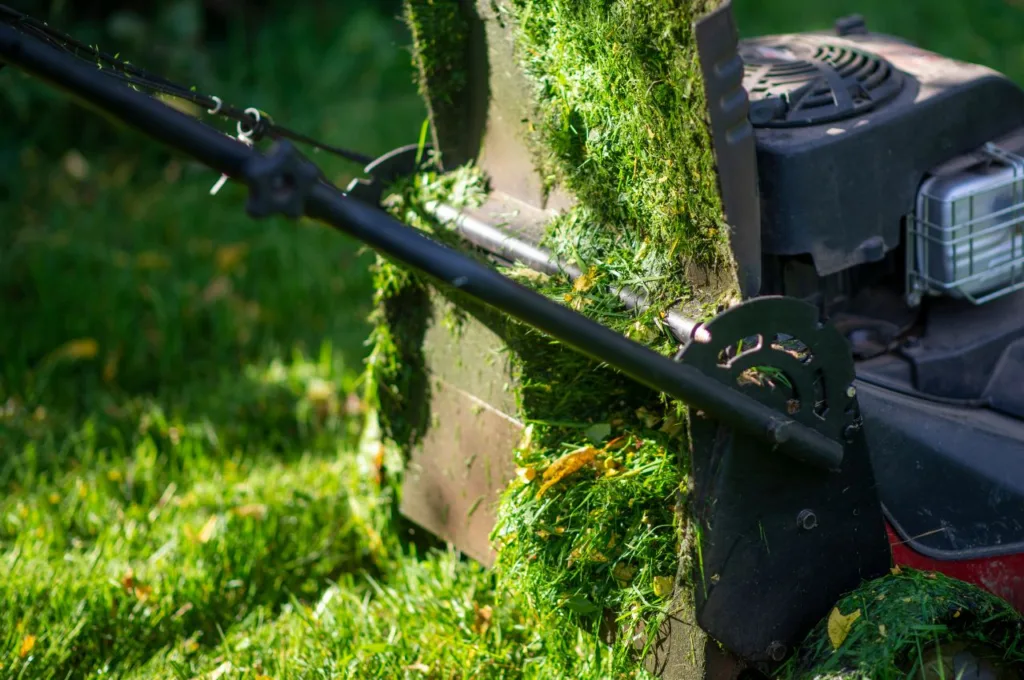
🏔 Reason #4: Mowing On Uneven Terrain
To some extent, mowing on uneven terrain might cause your lawn mower to vibrate more than normal.
When a mower operates on a bumpy or sloping lawn, the wheels may fall into divots and jump over hills, disrupting its smooth, consistent movement. A very bumpy lawn may also cause the mower’s cutting blades to hit the soil, further rattling the mower.
How To Resolve:
The good news is that excess vibration due to mowing on uneven terrain isn’t caused by an issue in the lawn mower itself.
You don’t have to do anything to resolve this issue, but if your lawn is very uneven or bumpy and you’re concerned that it’s causing excess wear on your mower’s parts, you can look into evening out your lawn by adding topsoil to the divots and pressing it down with your feet.

🟢 Reason #5: Damaged Flywheel Key
If you have a petrol mower, it’s possible that the flywheel key has become damaged, causing the lawn mower to vibrate excessively.
A flywheel key is a small, rectangular or square metal piece that connects the flywheel to the engine’s crankshaft. The purpose of this component is to ensure that the flywheel and crankshaft rotate together in perfect synchronization.
If the flywheel key becomes damaged or sheared, it’s no longer able to maintain this alignment, which disrupts the engine’s internal components, causing excessive vibration and a bumpier mowing experience for you.
How To Resolve:
Flywheel keys are cheap (less than £10), so the easiest way to resolve this issue is to replace the damaged flywheel key.
If you’re a confident DIY-er, you should be able to do this yourself. Disconnect the spark plug wire, then remove the engine cover and remove the flywheel nut or bolt. Lift off the flywheel and replace it with a new one (make sure it’s the same size). Reassemble the flywheel and engine cover, then, reconnect the spark plug wire and start the mower to check whether the vibrations have reduced.
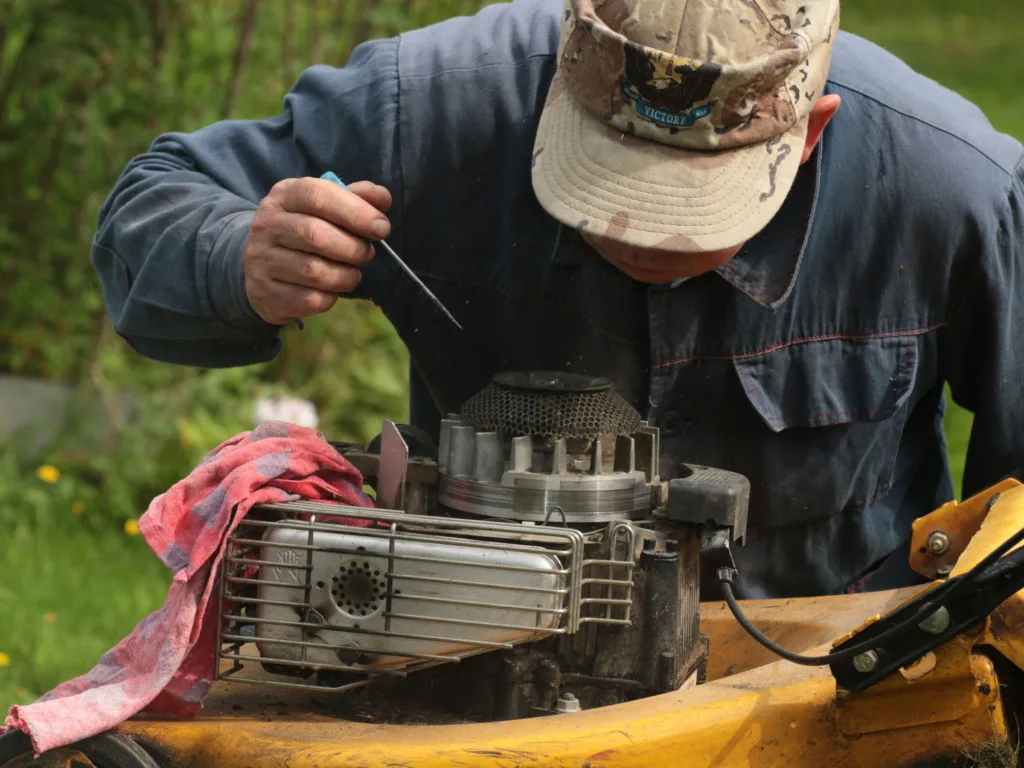
🔼 Reason #6: Overhead Valve Issues
Another possible cause of a badly vibrating push mower is an issue with the mower’s overhead valve system.
An overhead valve system is commonly used in small engines to boost efficiency and power output. When overhead valves develop issues, they can cause a lawn mower to vibrate during operation.
For instance, valve clearance problems (if the valves aren’t properly adjusted or are worn or damaged) may affect the engine’s combustion process and timing, leading to uneven power delivery and misfires. This increases the vibration in the mower body.
How To Resolve:
If you don’t mind getting stuck into some manual labor, you can resolve most overhead valve issues yourself.
Disconnect the spark plug, the open the engine’s valve cover to inspect the valve components. If you notice valve clearance problems, adjust the valve clearance according to the instructions in your user manual. If the valves are damaged or excessively worn, they may need to be replaced.
Once the adjustments and replacements are completed, reconnect the spark plug wire and test the mower.
🔧 Reason #7: Engine Needs Tuning
Again, if you have a petrol mower, the engine will need tuning occasionally – and failing to tune the engine may cause vibrations during operation.
If your mower engine runs rough, it won’t perform optimally due to a few different factors, including an imbalanced air-fuel mixture, dirty or clogged components, or ignition system issues. All of these could cause the engine to run erratically, resulting in excessive vibration.
Other signs that your engine needs tuning are if the mower gets harder to start and doesn’t seem as powerful as it did originally.
How To Resolve:
Resolving an issue with a rough-running engine is simple: just tune the engine.
To tune a lawn mower engine, wait for the engine to cool, then disconnect the spark plug wire. Clean the air filter to ensure proper airflow, then access the carburetor and adjust the air-fuel mixture to achieve the correct mixture ratio. Clean and replace the spark plug if necessary, and ensure the ignition system is in good condition, including the spark plug wire and ignition coil. Inspect and clean the fuel system.
Most small lawn mower engines need tuning once every 50 hours, or once a season, whatever comes first.
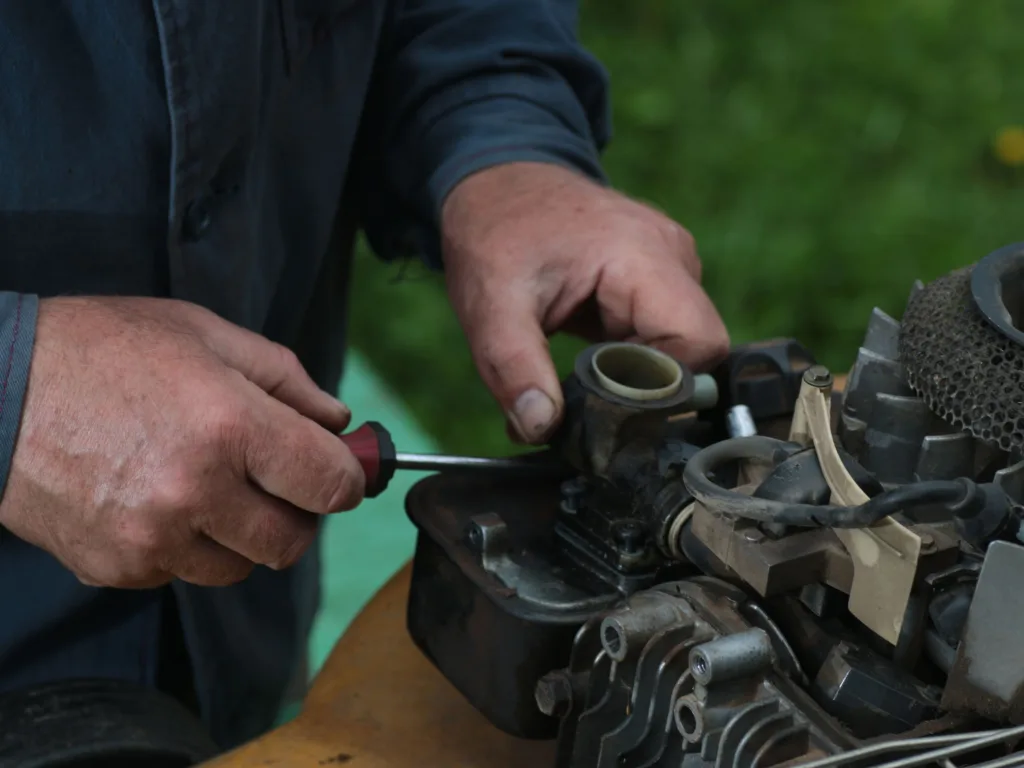
↪️ Reason #8: Bent Crankshaft
Finally, a bent crankshaft might be the reason why your lawn mower is vibrating excessively.
The crankshaft is responsible for converting the motion of the pistons into rotational motion, powering the lawn mower’s operation. If it becomes bent (which can happen if the mower suddenly strikes something solid), this misalignment causes the cutting blade to become unbalanced, leading to vibration in the mower body.
How To Resolve:
Fixing a bent or damaged crankshaft is a difficult task that we don’t recommend trying yourself. It’s best to leave this task to an expert!
However, if you happen to be experienced in small engines, you can fix the issue by locating the source of the issue, then testing the wobble of the blades and the bolt. From here, you’ll need to either straighten or replace the shaft – whatever is easiest.
🏁 Final Word
Thanks for reading this article – we hope you were able to troubleshoot your lawn mower vibration issue using the tips above.
If you have any further questions or your own words of wisdom for preventing excessive lawn mower vibration, we’d love to hear from you! Get in touch to chat about anything lawn mower-related – we’ll see how we can help.
